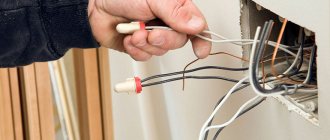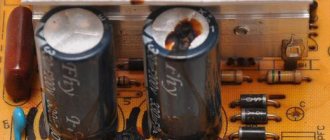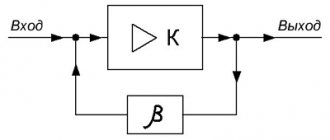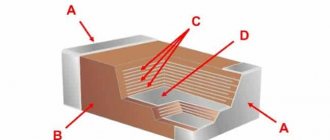For installation of metal products and repair work, DC welding is often used. Using rectifiers and inverters, you can change the polarity when welding and regulate the zone of maximum heating of the arc. It is worth talking about the nuances of direct and reverse connection of poles in detail: how the poles are connected, in which cases the minus is brought out to the electrode, what is the peculiarity of the seam with direct and reverse polarity.
Connectivity differences
Anyone who has used electric arc welding machines understands that we are talking about the distribution of poles between the holder and the workpiece. There are two types of polarity when welding:
- Direct, when electrons move towards the workpiece (minus on the electrode). The arc turns out compact and dense.
- Reverse, when a plus is connected to the holder. A diffuse area of contact between the arc and the metal is formed.
The main difference between direct and reverse polarity welding is the localization of the point of maximum heating. With direct heat, the metal heats up more, and with reverse heat, the consumables heat up more. The method of connecting the poles depends on the thickness and physical properties of the metal.
Differences in connecting direct and reverse polarity
What is polarity?
Polarity is a concept that defines the location of the pole terminals (external current-carrying elements) on the cover or front side of the battery. There are two standard position types:
- Straight.
- Reverse.
But the current leads can be located differently. Such “exotic” batteries have not caught on with car owners in Europe and the CIS countries, so they are extremely rare on store shelves. It remains to find out what the polarity of the battery is, direct or reverse, and whether there is a difference between the batteries.
Straight battery polarity
Batteries of this type were developed by Soviet engineers. All cars produced in the USSR were equipped with direct-type batteries. They are characterized by the following arrangement of pole terminals - “+” on the left and “-” on the right. Batteries are still produced with this arrangement of current leads today. A fairly impressive percentage of vehicles of foreign brands that are assembled in the CIS countries are equipped with a battery with a left “+”.
Reverse battery polarity
Reverse polarity batteries are manufactured by manufacturers in European countries. Therefore, all imported vehicles are equipped with batteries in which the current terminals are located exactly the opposite - “+” on the right and “-” on the left.
How are batteries different?
If we are talking only about polarity, then the only difference is the location of the current leads on the equipment cover. The layout of the polar terminals does not provide any physical or operational features to the battery, but when installing a battery of the wrong polarity into a vehicle, difficulties will inevitably arise with the length of the terminal wires. It does not matter that both the old battery and the new component are made by the same manufacturer. The wires are not long enough! To avoid additional expenses and loss of time on building up wires, it is wiser to immediately select and buy the right type of battery.
If we are talking about purchasing batteries from different manufacturers, then they may differ both in the location of “+” and “-”, as well as in geometry and dimensions.
This problem cannot be solved even by extending or replacing wires, since the mounting location for the component always has strict geometric and physical parameters. The spare part may not fit into the seat. Under favorable circumstances, wrong battery polarity may not be a problem. If you can install it in the socket correctly, turning it 1800. In this case, the length of the terminal wires will be sufficient.
Features of straight polarity when welding
First, a few words about the scope of application of straight polarity in welding. It is extensive and is used:
- When installing rolled steel from carbon, low-alloy, special steels using consumable electrodes.
- When welding is performed with a tungsten non-consumable electrode using a surfacing wire. A refractory rod is needed for butt joints of thin parts and non-ferrous metals; it is used when working with fluid alloys.
- For cutting workpieces using welding equipment.
Advantages of current standard terminal connection:
- a narrow suture bead is formed;
- due to the high plasma density, the workpiece is boiled deeply;
- a wide range of surfacing electrodes with various types of coatings is produced;
- a stable arc is maintained.
Disadvantages of direct connection:
- the metal is strongly sprayed (a dense stream of plasma hits the melt pool with force);
- there is a high risk of burning through thin parts;
- residual stresses arise in the heat-affected zone.
So, with a direct connection, the cable from the positive terminal is connected to the workpiece, and from the negative socket it is led out to the electrode holder.
Terminal designation
What might the markings on the terminals mean? As shown in the photo, the terminals can have several types of markings, by which the polarity of the battery can be determined. There are only 3 options used in the world:
- “+” and “-”;
- "POS" and "NEG";
- "P" and "N".
These designations were introduced for a reason, so you need to understand the marking designations of a car battery. If you mix up the connection, there will be many problems. Not all blocks and modules in the car are equipped with additional protective components that will prevent polarity reversal - therefore they will fail, at the same time fuses will blow and many current sources in the circuits will overheat. Due to the likelihood of a short circuit, the battery itself can be seriously damaged.
Type of current
The peculiarity of welding with alternating current is that when the sinusoid passes through zero, the arc goes out and then flares up again. The human eye does not detect this at high current frequencies. The conclusion immediately suggests itself: the type of current affects the stability of the arc. It is no coincidence that high frequency alternating current is used for welding.
When the device produces direct current, welding capabilities increase, you can change the direction of the flow of electrons, and influence the density of the electric arc. The strength of the connections formed ultimately depends on the type and polarity of the current.
Let me clarify: the polarity changes only when working with direct current.
For alternating current generators, the wires can be connected in any order; this does not affect the welding process.
When choosing electrodes, it is important to consider the type of current. When buying consumables, you need to carefully study the instructions; the necessary instructions are always given there. Electrodes are available for direct or alternating current and are universal. For example, UONII - for permanent. But it is most convenient to work with universal rods; there are fewer problems with them. Prepared the required amount, heated it to the specified temperature, and got to work.
Design features of the battery
A car battery is a rechargeable DC source that is used to power the electrical system and start the engine. Cars have different layouts of components, so the polarity of the battery is as different as the type of terminals. In Europe, two types of cone-shaped batteries are used:
- Type A - 19.5 mm for positive and 17.9 mm for negative.
- Type B - 12.7 mm positive and 11.1 mm negative.
There are also other types - F, G, T, H, D, C, and E, but these are no longer cone-shaped, but in the form of threaded studs, terminals, lugs and other modifications. The terminals can be located on the top or on the front side wall.
Polarity when operating semi-automatically
A distinctive feature of semi-automatic devices is the supply of filler wire in automatic mode, at a fixed speed. It is clear that in this case the seam bead turns out neat and even, because the metal is melted evenly. To generate current, an inverter is used - a compact converter with electronic filling and additional functions that facilitate the welding process.
The specifics of automatic welding provide for several operating modes of the equipment:
- in the open air with an additive that forms a slag layer;
- using wire containing fluxes;
- in a protective gas environment covering the working area.
The connection of the terminals depends on the type of mode. Straight is suitable for ordinary cored wire. They switch to the reverse:
- using a protective gas, ionized molecules perfectly transmit electrons, the arc flares up quickly;
- Using a flux additive, heat is concentrated at the tip of the deposit, the flux burns out completely, and a homogeneous diffuse layer is formed.
Working with modern welding equipment, when connecting the terminals back, you can adjust the stability of the arc.
Knowing the features of working on alternating current, you can select the welding mode to suit the size of the workpiece and the type of metal. Direct current provides great opportunities; by changing the position of the poles, the welder controls the position of the high-temperature region of the arc. By shifting the position of the anode spot, strong connections are obtained on any workpiece.
Possible problems
If you purchase the “wrong” battery, the operation of the equipment becomes impossible. Difficulties begin at the installation stage.
Battery device
Lack of experience and low concentration can lead to:
- blown fuses;
- wire melting;
- ECU failure, alarm system;
- damage to electrical wiring;
- diode bridge burnout.
Reversing the polarity of the battery (60, 70 Ah) with reverse polarity provokes the appearance of sparks. If signs of fire occur, the procedure should be stopped. Changing the location of the terminals will not work.
In exceptional cases, a car owner will be able to use a battery from a different category. A mandatory item is to change the position of the battery by 180 degrees. This is necessary to ensure that the terminals and pins match.
This installation method will not work if the wires are not long enough. Under the current circumstances, the engine generator cannot be combined with the main “mass” of the vehicle. To avoid such problems, the wires are made longer. Their diameter should be the same.
Is it possible to change the polarity on a car battery?
Nowadays, most manufacturers strive to eliminate the possibility of incorrect connection. For this purpose, the negative and positive terminals are made of different sizes. The wires from the on-board network have a certain length and can only be attached to the required sides. But car owners have the opportunity to bypass the protection by connecting the contact through an adapter.
Battery adapter
As a result, the plus becomes on the wrong side, a polarity reversal occurs, which is dangerous for all car systems. Of course, some car owners specifically reverse the polarity of the old battery in order to extend its life. But this operation must be performed at your own peril and risk, and the consequences are often unpleasant. Polarity reversal is only possible under the following circumstances:
- The banks are in good working order and do not short out.
- Inside the battery, normal electrolyte density is maintained.
- The plates are quite thick and have no damage.
If you urgently need to replace the battery, you can install the device with inappropriate polarity. In this situation, the battery must be installed so that the wire with a positive charge reaches the terminal. The negative one is mass; it is attached to the body, so it can be extended. To do this, the old wire is disconnected, and a new one with a larger cross-section is fixed in its place. Unfortunately, the positive one cannot be unscrewed and cannot be replaced or extended.
How are batteries different?
The differences are minimal, except for the pole. I would like to note that externally the batteries are almost identical - that is, the body, the number of cans, the current strength, and even the label. And it is very easy to confuse the battery, that is, you can buy it with the wrong location of the current leads (terminals). Even an experienced driver can get into trouble if he makes a spontaneous choice. Therefore, if you yourself do not understand this, ask the seller to choose one for your car; as a rule, they have catalogs that describe suitable models. It will be best this way!
Therefore, if you are thinking about replacing the battery, you need to know exactly and determine the location of the terminals, this is extremely important!
Consequences of incorrect connection
Many inexperienced car owners wonder whether it is possible to install batteries with a different polarity in the car and what the consequences of an incorrect connection may be. Mixed terminals can lead to serious consequences.
Serious damage that can result from choosing a car battery with the wrong polarity includes:
- A short circuit that ends with several fuses blowing. This kind of damage can be fixed quickly and inexpensively. You can prevent burnout if you promptly notice the sparks that appear when connecting the battery.
- Ignition that occurs when an incorrectly connected battery is used for a long time. Because of this, small wires light up first, and then larger elements.
- Destruction of the battery, which occurs due to the melting of some parts and discharge of the battery due to the effects of reverse charge.
- A breakdown of the on-board computer, the repair of which will be expensive for any driver due to the high cost of a new board.
- Burning fuses, which can be replaced with new protective elements within a few minutes.
- A generator breakdown, the replacement of which can hit the pocket of an inattentive motorist. Often, protective fuses are installed on it to prevent such breakdowns. In this case, you will not have to change the generator; it will be enough to buy a new diode bridge.
- Damage to electrical wires and alarms, which quickly fail if the battery is installed incorrectly.
In any case, it is better to change the battery with the wrong polarity. The discrepancy between the model will help determine the length of the negative and positive wires, which simply will not be enough for connection. Of course, you can cheat and lengthen them, but an incorrectly selected cross-section or weak braid will lead to the same consequences as an incorrectly selected battery.
We recommend: Search and selection of batteries by car make and model
Video about direct and reverse battery polarity
Determining the polarity of a car battery
Car batteries: how to choose, expert advice. avtozvuk.ua











